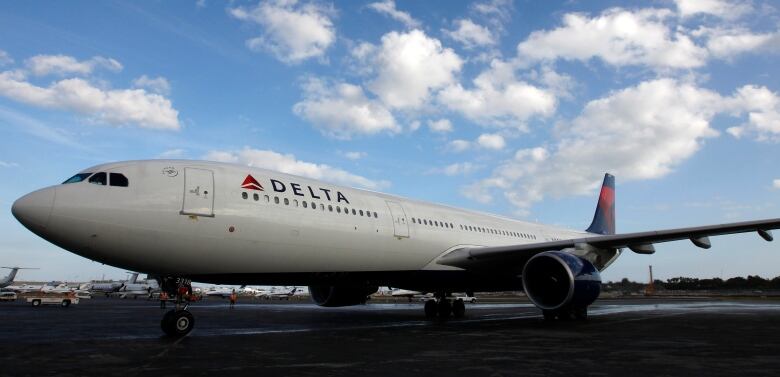Sky-high Wi-Fi: Canada's airlines roll out more internet
Air Canada and WestJet expanding wireless access, but Canada lags behind U.S.

In-flight internet service is becoming more prevalent on Canadian airlines, but still lags behind U.S. airlines in terms of access.
Canada's two largest airlines Air Canada and WestJet plan to outfit a majority of their North American flights with Wi-Fi access this year.
- Air Canada Wi-Fi to be available across North America
- What's behind WestJet's new Connect Wi-Fi system
- Ottawa to allow passengers to use electronic devices on takeoff, landing
Air Canada, which began rolling out Wi-Fi service in 2014, has outfitted 120 out of 129 of its mainline flight of single-aisle aircraft with Wi-Fi capability, saysAir Canada spokesman Peter Fitzpatrick. The remaining nine aircraft are due to be finished in March.
The company also plans to add Wi-Fi to its wide-body international aircraft for flights between continents, though the airline could not provide further details.
"Customer response has been positive, which is why we are going ahead and expanding Wi-Fi to our international fleet," Fitzpatrick told CBC News in an email.

WestJet began to roll out WestJet Connect, its own Wi-Fi and entertainment system, in 2015. The airline offers Wi-Fi service on 30 per cent of its aircraft, and expects to have the service on a majority of its aircraft by the end of the year, says WestJet spokeswoman Lauren Stewart.
"We had heard from customers over the years this is something they'd be interested in," said Stewart. "This is something they were asking for."
Wi-Fi internet access on airlines for both networks, and on airlines around the world, only functions at cruising altitude.
Other notable Canadian airlinessuch as Porter, Air Transat and Sunwingdo not offer internet service on flights.
U.S. ahead in offering Wi-Fi service
A reportby Routehappy, a flight information service, shows that 78 per cent of seat-miles on U.S. airlines have internet access, or have access being rolled out, compared to 24 per cent for the rest of the world. Seat-miles are a measure of airline carrying capacity and are the number of seats multiplied by miles flown.
For a Canadian comparison, on an average travel day, Air Canada only has Wi-Fi access on 18.53 per cent of its seat-miles, partially because it does not have Wi-Fi on its long international flights, according to Routehappy.
Large American airlines such as Delta and United offer Wi-Fi on more than 80 per centof their seat-miles.
No figure was available for total availablity of Wi-Fion all Canadian airlines.
Jason Rabinowitz, Routehappy's data manager, said the gap between the U.S. and the world is largely because of the Gogo network infrastructure. Gogo is a ground-to-air Wi-Fi network that services several of North America's biggest airlines, including Air Canada, American, Delta and United.

Rabinowitz said that the service has allowed the U.S. to get ahead of other countries in airline Wi-Fi.
"The U.S. airlines have the distinct advantage of having Gogo's air-to-ground network, which has been in place since about 2008," he said. "It's a unique network that doesn't exist right now anywhere else in the world."
Air Canada began to use Gogo in 2014 as the network expanded its range to the southern portion of Canada.
Another challenge for airlines adding Wi-Fi service is the cost of installation.
"The numbers are a little bit muddied, but the install, depending on the system, can be anywhere from a couple dozen thousand dollars to upwards of $100,000 per aircraft," said Rabinowitz. "It's a very, very significant hurdle for the airlines to really budget for."
Despite Canada, and the rest of the world, being well behind the U.S. in Wi-Fi access, Rabinowitz said Canadians have reasons to be optimistic.
"Theodds of gettingWi-Fion Canadian carriers are getting better every day," he said."Now is better than ever as far asWi-Figoes in Canadian airspace."
Similar costs

The Gogo network used by Air Canada and several large American airlines usually sets rates consistently across North America, according to Gogo spokesman Steve Nolan. Rates for use of Gogo are at $5 US per hourand $16 US for a day pass.
WestJet uses its own satellite technology for WestJet Connect and charges$5 Cdnper half-hour and $8 Cdnfor a full-flight pass.
The capabilities of the two network connections is also similar. Both WestJet Connect and Gogo offeraccess to email, web browsing and social media.
However, higher-bandwidth applications like video streaming are not yet possible on the two networks.
WestJet Connect service does offer its own complimentary package of movies and television to view on electronic devices through use of servers aboard the plane. Air Transat has a similar service.
The Gogo network also offers an analogousservice on several airlines, though not Air Canada.












_(720p).jpg)


 OFFICIAL HD MUSIC VIDEO.jpg)
.jpg)



























































































